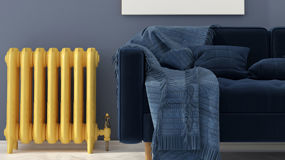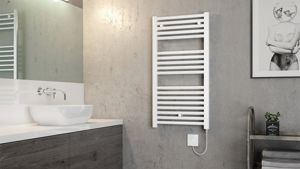Buying a radiator isn’t simple. But it can be. The sheer amount of options and designs can makes choosing a radiator a bit of a headache. Here's our guide on how to choose a radiator, with links to more information in each section.
How To Choose A Radiator
When choosing your radiator, you firstly need to decide how you want it to be heated. You have 3 options for this:
Central Heating Radiators
A central heating radiator is your typical radiator. Essentially, a metal container that fills with hot water which is heated by the boiler. That heat then escapes into your home at a rate that depends on its material, size, and design.
Electric Radiators
Electric radiators are, as you can guess, a container full of fluid (often thermo-fluid) that is heated by an electrical element. All powered by your nearest power socket or wired directly to your main supply.
Dual Fuel Radiators
Typically a standard central heating radiator with a mains-powered 'summer heating element' inserted into it. This gives you the option of heating the radiator using electric, even if your central heating is off. This heating method is great for towel radiators.
Radiator Types
There are a wide variety of different radiator types for you to choose from. Below we outline the benefits and potential drawbacks of each so you can choose the best radiator for you!
Single Panel Radiators
Single ‘panels’ (think of them as ‘hot water containers’ instead) are your basic radiator. A single panel, mounted to the wall, facing outwards into the room. It might also be split up into multiple columns for more surface area - but it’s still a single panel. Single panels are slimmer and fit closer against the wall than doubles.
Double Panel Radiators
Double panel radiators are two single panels stacked against each other (for roughly twice the power) and mounted to your wall. They can end up sticking out quite far from your wall - but in some designs, this might be a good thing.
Horizontal Radiators
Horizontal Radiators are your standard wider-than-they-are-taller shape. Found everywhere and usually under the window (traditionally to warm those cold draughts).
- The safe option design-wise, your typical white radiator fits in everywhere.
- More common, more choice, less expensive.
Vertical Radiators
Vertical Radiators are tall, space saving, and since they’re more obvious than horizontal radiators they’re normally much more decorative.
- Can free up a lot of space in the right room.
- Great for making a statement with - there’s plenty of designer vertical radiators to choose from.
Column Radiators
Column radiators are made from tubes arranged in rows that connect at the top and bottom to form a single section (unlike a double panel radiator). They’re often more traditional in design and probably what comes to mind when I say “Victorian radiator”.
Heated Towel Rails
Towel rails and ladder rails are bathroom radiators made primarily for heating towels to make them warm and fluffy (perfect for those cold winter mornings) as well as drying them; heating rooms is only their secondary function - though they can easily heat smaller bathrooms - as such they tend to be far less powerful (and cheaper to run). Many radiators have slots cut for hanging towels, but using it just to heat towels would be expensive - hence a towel rail.
Check out some of our favourite radiators below or click the link to view the full range!
What Is the Best Radiator Material?
When you choose a radiator, what it's made from affects how quickly it heats up and how quickly it cools. “What radiator material is best?” is a common question and while aluminium is technically the best, it's also typically pricier than other materials. Though you will get that money back in the long run. And for someone looking to save money in the short term (aluminium is great for long term savings) then a different material might be better.
Cast Iron
Cast iron was popular before modern insulation because it took ages to heat up and ages to cool down. If the Victorian look is all you want, then stainless steel versions of old cast iron designs are available. Take a look here.
Mild Steel
Mild steel is very common and low cost. You’ll find plenty of good-looking designs as well as a range of painted colours. Let's take a peek at some of our greatest hits below, and you can shop the full range here.
Stainless Steel
Stainless steel doesn’t rust and stays warm for long after you turn off the heating. However, not all stainless steel is created equal, so make sure you buy from a good manufacturer. It’s a solid choice, but the prices reflect the quality. Shop out great selection here.
Aluminium
Aluminium is a superconductor, meaning the moment you turn it on it immediately starts to heat your home. It also cools immediately so achieving the perfect temperature is easy. They’re also lightweight and easy to install (so lower installation fees). We have a fantastic range of aluminium radiators here.
Other Radiator Considerations
So you've chosen your perfect radiator type, what other things do you need to consider?
Cost
More important than how it looks, and more important than anything really when you choose a radiator. Your budget. Only Radiators has the most affordable selection of radiators, so that's a good place to browse to get an idea of prices. But really it all depends on a few different factors, such as knowing how materials affect the price of your radiators.
Valves
Yes, valves, two of them (they're sold in pairs). So you’ll need to purchase a pair of valves for every single radiator you buy. It’s very rare that a pair of valves will be included with a radiator.
Find out how to choose the best pair in our guide to choosing the best radiator valves.
Installation
Short answer: Just pay a professional, this thing is going to be fed full of hot water while people gather around it - mistakes can cause a lot of damage to your home - and do you really want to go through all the effort just to risk having it break down in the middle of winter? What a Christmas to remember.
Long answer: Fancy yourself a DIY champ? If you think you've got it in you, then why not? Just be sure you are fully informed and if you aren't 100% confident - get a professional in!
What is a BTU and How Much Do I Need?
BTU is the measure of heat output. The higher the BTU, the hotter your radiator can get. Watts are the same, except they refer to electric radiators.
When buying a radiator, the standard practice is to use a BTU calculator to figure out how much BTU you need.
More BTU means it’s more expensive to run, but you can always just turn it down; after all, it’s nice to have it just-in-case, than need it and not have it.
Choosing The Best Radiator Size
Size, along with material, affects the BTU output - bigger radiators are likely to put out more - but when thinking about size, don’t forget about depth.
Example: You could choose a radiator that’s really long, really tall, but you could also get a compact one with plenty of depth, like a double panel convector. Equally, you could have two single panel vertical radiators to avoid a chunky look and they would look almost like wall decorations.
Basically just use the BTU calculator to figure out what you need, and then it’s all down to how you want the room to look.
What Other Radiator Accessories Are There?
Central Heating Inhibitors
Very important when adding new radiators to your system. They coat the surface of the metal and prevents the metal in your system from rusting and reacting with anything else. Your system will be well looked after for many rust free years.
Radiator Boosters
These are essentially fans that sit atop a radiator to blow the hot air into the room, making the radiator more efficient and (in theory) saving you money. Like any ‘gadget’ it really comes down to the type you buy, and who from.
Decorative Radiator Valves
Decorative radiator valves could be considered non-essential (as long as you DO already have valves) and there’s plenty of wonderful options out there. The effect they can have on a design is substantial.
Paint
A great way to keep a radiator looking like new, and no, it doesn’t even have to be the same colour. It comes in tubs or in spray form. Black radiators fit with all aesthetics and offer a stylish but minimal look.
So knowing how to choose a radiator and make a great choice begins with having an idea of what you want from a radiator. You might only need a slightly warmer radiator than you have now, but it's the bathroom, making a heated towel rail an ideal choice. Next is knowing your technical limitations such as the angle of your piping, how large the room is, and details such as number of windows. From there you're free to browse purely on aesthetics and choose a radiator that doesn't just warm your home, but warms your heart too.










